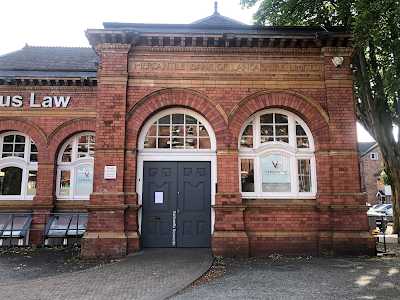Founded as a wing of The Manchester Royal Infirmary in 1763 and on its present site since 1848/9 as a mental hospital Cheadle Royal was not much used for war casualties during the First World War.
 |
| Cheadle Royal Hospital September 2019 |
The treatment of what was then referred to as
“shell shock” (1) was quite limited indeed sufferers were widely regarded as shirkers or who at best were
“lacking in moral fibre”.
Indeed in 1917 the British Army issued a general order effectively banning any use of the term
“shell shock” in casualty records. Some soldiers were treated in the nearby Barnes Convalescent Home which was more widely used in the Second World War.
As
written about in a recent post the hospital has a war memorial listing 7 members of staff who fell during the conflict. The story of one, John Bennett has already been told. Some details on the lives of 3 of the remaining 6 are recorded in this story.
 |
| The War Memorial – Cheadle Royal Hospital |
I was puzzled at first that three of the remaining 6, like John Bennett himself, had served in a Welsh regiment, however in the 1870’s the hospital had expanded by purchasing a number of houses in the Colwyn Bay area of Denbighshire in North Wales.
Further expansion saw the addition of “Glan-y-Don Hall” a purpose-built convalescent home in 1909/10. (2) Presumably, some of those joining the Welsh regiments were working at one of these satellite sites.
Thomas Massey was born on 3rd March 1884 and christened at St. Bartholomew’s Church, Wilmslow, Cheshire on 23rd September 1888. His parents were William, a gardener, and his wife Elizabeth (née Moore) of Altrincham Road, Morley, Nr. Wilmslow, Cheshire.
He enlisted at Colwyn Bay, North Wales on 3rd November 1915 when he was recorded as being 30 years and 7 months old and employed, also as a gardener, at Greenfield House, Old Colwyn.
A few days later on the 8th November, at Conway, he joined as a private the 20th battalion (later transferring to the 16th) of The Royal Welsh Fusiliers, arrived in France on the 19th March 1916 and was killed in action on 11th November of the same year. Private Massey’s remains are interred in one of the 1102 graves in the “Essex Farm Cemetery” close to the town of Ypres in Belgium.
This famous poem was written next to Essex Farm Cemetery.
Reginald Stansfield Carr was killed in action on 22nd April, 1918 during the “Ludendorf Offensive” the final throw of the dice by the German Army, an attempt to achieve a decisive victory before the arrival of a substantial United States Army force would make their ultimate defeat inevitable.
Although he was serving in the 14th battalion of the Royal Welsh Fusiliers when he died he had in fact enlisted at Stockport in and joined the Cheshire Regiment. He was born in Stockport, Cheshire in the December quarter of 1896 to William Arthur Carr, a blacksmith in a “shoeing forge”, and his wife Jemima (née Goodier). The family home was at 18, Church Road, Cheadle, Cheshire. According to the 1911 census Reginald was employed as a van boy. Private Carr has no known grave and his name is included on the Poziers Memorial in the Somme Department of Northern France.
The Poziers Memorial
 |
| The Poziers Memorial |
The third member of a Welsh Regiment on the memorial is George Richard Featherstone of the 10th Battalion, South Wales Borderers. He died of wounds on 18th August 1917 and is buried in the Military Cemetery at Dozinghem, Belgium.
George Richard was born in 1882 in Cross Acres, Northern Etchells, Cheshire. His parents were Tom, a farm labourer from Biggin, Derbyshire and his Manchester-born wife, Kate. On joining the army, in Stockport, George left behind him a young family; wife Emma (née Adshead) and four young children. George and Emma were married at All Saints Church, Newton Heath Manchester on 25th May 1905.
The couple set up home in Cheadle, Cheshire where George worked as a groom / coachman. Their first child Tom was born in Cheadle during the September quarter of 1905, two daughters quickly followed Katherine Mary, (born 1907 December quarter) and Jessie (born March quarter of 1910). The final addition to the family a second son, Clifford, was born, also in Cheadle, on the portentous date of 11th November 1914.
The National Register taken on 29th September, 1939 shows that his widow, Emma, and his youngest son, Clifford, were still living at 153, Wilmslow Road, Cheadle which had been the family home from before the 1911 census. Emma was recorded as a laundry worker whilst Clifford was employed as a glove salesman.
I shall tell the stories of the remaining three soldiers on this memorial at a future date.
© Tony Goulding, 2020
Pictures; courtesy of Tony Goulding, except The Poziers Memorial, The Cross of Sacrifice licensed by the author Wernervc, under "Creative Commons Attribution Share Alike 4.0 International License"
Notes:
1)
“Shell Shock” was recognised in the 1920’s as a genuine condition.
In World War Two, similar cases were referred to as “Combat Stress” and the condition is now known as P.T.S.D. or Post-Traumatic Stress Disorder.
2)
The architect was the Manchester based Percy Worthington.


















































